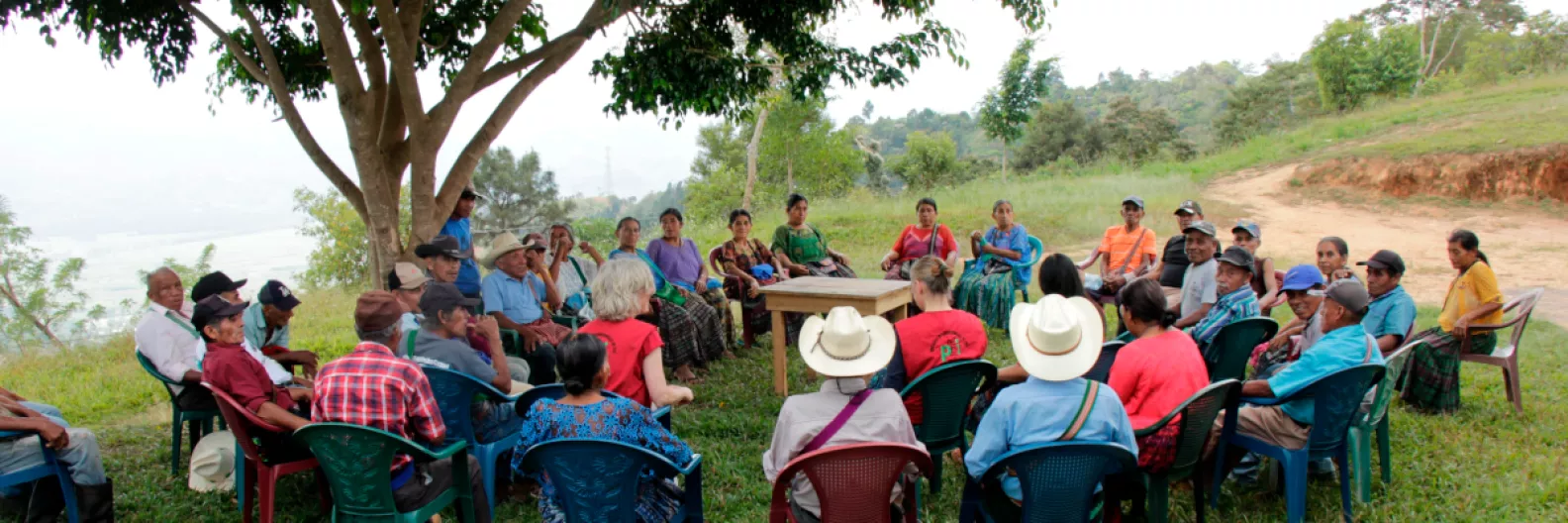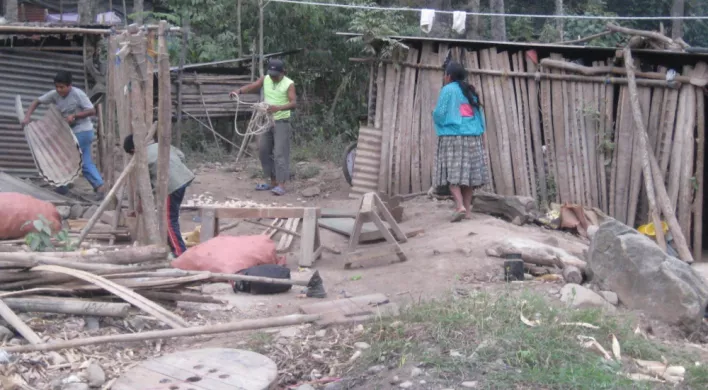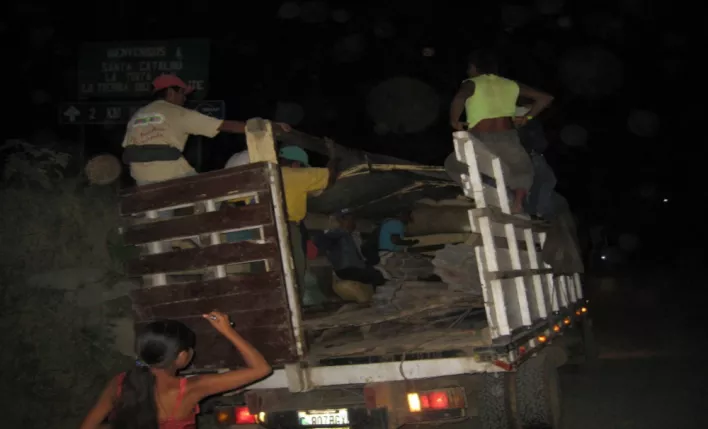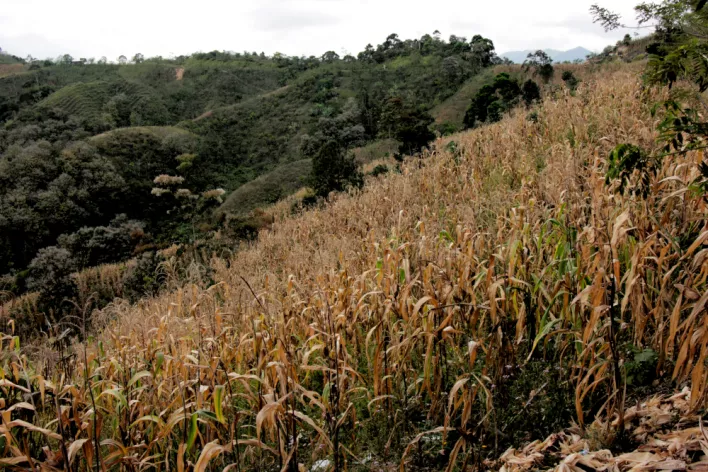
Between 2006 and 2010, PBI accompanied 149 Q’eqchi’ peasant families from Finca La Mocca, members of the Verapaz Union of Campesino Organizations (UVOC), in their struggle to have their right to access to land recognized. Thirteen years later, we met with these families once more to reflect on those times and learn about what happened after the land was handed over. 1

The origins: chronology of the conflict on the La Mocca Farm
Finca San José La Mocca, belonging to the Hempstead Dieseldorff family, can be found in the Polochic Valley, on the border between the municipalities of Senahú and Santa Catalina La Tinta, Alta Verapaz. The farm is strategically located between the jungles of Guatemala’s northern lowlands band the southern municipality of Panzós and the Polochic River. The history of this farm exemplifies the problem of the unequal distribution of land, which historian Severo Martínez Peláez identified as the primary problem in Guatemalan society. Land is concentrated in the hands of the few while the vast majority of the peasant population lacks access to land. This case also illustrates the historical racism inherent to a colonial development model which, since the liberal reform, has based its productivity on the quasi-slave labor of indigenous families forced to work in the coffee farms in the position of mozo colono (literally colonial peasant hand). 2 Furthermore, this case also represents what has come to be known as the “failed state”, as it demonstrates the State’s inability to guarantee the population’s basic rights: healthy and sufficient food, drinking water, decent housing and security.
The Q’eqchi’ peasant families who are the protagonists of this story lived and worked for many years as mozos colonos at Finca La Mocca, which dedicated its approximately 100 caballerias to the cultivation of coffee and cardamom and cattle ranching. At the beginning of the new millennium, the fall in coffee prices and the interest in of producing other, more profitable and less labor-intensive products, such as eucalyptus, led the owners to dispense with the work of some of the 1,100 Q’eqchi’ families that lived and worked on the farm. However, the owners did not pay the benefits due for the years worked. Nor did they provide all the families with compensation through land; only about two thirds of the families benefited from this. In addition, the land concessions were made without taking into account the years worked by each family, which caused community division.
235 of the families who did not received compensation for the years they had worked, founded the Peasant Development Association of San José Mocca (ACDSJM) in 2003, to claim their labor benefits and land. A year later, they joined UVOC in search of political and legal cover for their demands. With UVOC’s support, they obtained a court ruling that established their right to receive monetary or land compensation for the work provided. This ruling, however, was not complied with. Faced with the lack of response from the owners of the farm, and as a measure of pressure to resolve their situation, they moved to Finca Las Cabañas in 2005. This land is owned by the same owners as La Mocca and located across the road from it.
The lack of political will for resolving the conflict meant the families were subjected to three violent evictions and several confrontations with groups related to the farmers, which left dozens of people injured and three dead. Miguel Quib, who died in the July 2006 confrontations; José María Cu, died a year later due to injuries received in the July 2006 confrontations; and Carlos Chub Che, who was murdered in April 2007. Seventeen years later, the families of these people are still waiting for the material and intellectual authors of these murders to be identified and brought to justice.
Faced with violence and evictions, the families had no alternative but to settle on the road next to the land where they had lived on all their lives. While there they experienced the adverse effects of the weather, malnutrition, lack of access to health, education and unemployment. Meanwhile, with the accompaniment of UVOC, they continued negotiating in the National Roundtable for the Resolution of Agrarian Conflicts to secure a place to live and the payment of the labor benefits that the farmers owed them for their work.

Although the case was prioritized as urgent due to the extreme poverty in which the families lived, it took the State four years to award them land. It should be noted that the Dieseldorf family did not provide the due compensation for the years of labor the families had provided, rather the land the families received was purchased by the State from other farmers and awarded to the La Mocca families.
In February 2010, 149 peasant families who had endured living on the roadside officially received three and a half manzanas of land each,4 located on the road that connects Santa Catalina La Tinta with Senahú. They obtained communal title to the land, which was granted to them through the Crisis Fund of the now defunct Secretariat of Agrarian Affairs (SAA), but they did not receive initial investment capital for the development of the community.
Relying on the sole support of a small truck made available by UVOC, one by one the families moved to the new land. It took a whole year for them to move off the roadside.

What the community effort achieved: organization is the basis for survival. 5
We were welcomed by 35 people from the community under the shade of a large tree beside the community church. Most of those who joined us were elderly men and women who were the protagonists of this struggle and who shared the long road they have traveled over all these years. They explained to us the organizational process they went through once they arrived at their new home, where the families again had to rely only on their own strength and the mutual support they gave each other through the community organization. “The state bought the land, but did not follow up on the transfer here, nor did it provide us with housing or support for planting.”
The new community was designed around the Mayan cosmovision: the energy of the Tz’ikin nahual and the connection of the new land with determined its name: Kab’laju’ Tz’ikin6 which means 12 Eagles in Spanish. Sandra Calel, from UVOC, narrates how “for the families the eagle represents the flight they made from La Mocca to the new land, achieving their goal of being able to start a better life.” The families designed the new community organization according to the Mayan cross, placing the community spaces in the center and grouping the families in five areas, according to the nahual of the women of each family. “The community organization was an impeccable process. 12 Tz’ikin is the first community whose land ownership documentation was issued in the names of both the men and women of each family,” says Sandra Calel. The families have organized themselves into committees for health, education, environmental care, sports, women’s organization, etc. They also have a council of authorities, responsible for looking after the land, made up of 20 elders.
“The beginning was hard,” they share with us. “We arrived on land that was dry and which had nothing. It took time to build houses. At first we lived in nylon shacks, made from boards and sheets brought from the roadside. Now we have wood-burning stoves and light from solar panels in the community buildings.” After further struggles and demands, the community opened a school nine years ago, which provides education from pre-primary to sixth grade, with 188 children between four and eleven years of age currently enrolled. It is staffed by six Q’eqchi’ teachers who come from Senahú three or four days a week. The health center was another result of their struggle. However, the doctor only comes once or twice a month.
The main problems they are experiencing at the moment continue to be lack of land and water. “The land is not enough and it is very tired. There were no trees here, everything was dry. We planted trees and began to recover the land, although it costs a lot because we do not have support from the Ministry of Agriculture, Livestock and Food (MAGA) for inputs, nor for training to improve the productivity of the land through fertilizers and cultivation.” In addition to low productivity, land has become scarce again as the community has grown. “We grow corn, beans, chili, marzipan, pineapple, mango, banana, mandarin, cassava, sweet potato for our own consumption. However, the corn is not even enough for the families’ own consumption and we have to buy extra. With the growth of the community, which now has about 800 people, the young people are forced to go out to work outside. Some do seasonal work as laborers on the farms, others migrate to the United States. The land is not enough.

The most serious problem affecting the community is the lack of drinking water. “Every day it takes us an hour to walk to the two nearest water sources. Women are the main ones affected by the water shortage, as they are the ones who are mainly responsible for supplying the family with this vital liquid for drinking and personal hygiene, but also for cooking and washing clothes. Faced with the lack of answers from the authorities and the unwillingness to invest in water and sanitation systems, the families are once again looking for solutions on their own, even if only in the short term, such as gathering large water tanks to collect rainwater. “The community has grown and the two water sources that supply us also serve other neighboring communities. In summer they dry up because there are no trees and also because of the nearby hydroelectric plants. Our main problem is the lack of drinking water.”
Although they managed to secure ownership over the land, the elders of the community have not stopped fighting to have their labor rights recognized for the years they have worked at La Mocca. Sandra Calel explains other challenges that the families are now facing: “There are farmers who have worked up to 39 years for 25 cents a day. The farmers have not compensated these families, even though there is a judicial resolution recognizing their rights. Another struggle now, in which we are accompanying them from UVOC, is to claim retirement and thus see the rights earned during so many years of work recognized.”
1 The information included in this section has been taken from the following sources:: UVOC, Guatemala: asesinatos impunes en la finca Mocca, 13.08.2007; UDEFEGUA, Criminalización en contra de defensores y defensoras de derechos humanos. Reflexión sobre mecanismos de protección, Guatemala, diciembre de 2009; UDEFEGUA, Informe sobre situación de violación de derechos humanos contra: LA ASOCIACIÓN CAMPESINA SAN JOSÉ LA MOCA, SENAHÚ, ALTA VERAPAZ. Miembro de la Unión Verapacense de Organizaciones Campesinas-CNOC, 14.07.2006; PBI Guatemala, La Mocca: crónica de una muerte anunciada, Boletín nº10, septiembre 2006 ;PBI Guatemala, PIM número 77, febrero de 2010.
2 This term is of colonial origin and established labor relations whereby some peasants worked extensions of land owned by landlords, who in exchange for this work, were allowed to live there and to cultivate the land. (Quiles Sendra, J., ¡Defendemos la vida! Las luchas sociales en Alta Verapaz, PBI Guatemala, 2019). In the case of the La Mocca farm, at harvest time they were also compensated with a small amount of money..
4 Equivale 21 hectáreas.
5 The information for this section was drawn from interviews conducted by PBI in March 2023 with members of the 12 Águilas community and UVOC.
6 In Mayan culture, the nahual is a protective spirit that is acquired at birth and that protects throughout life. Tz’ikin means bird.
